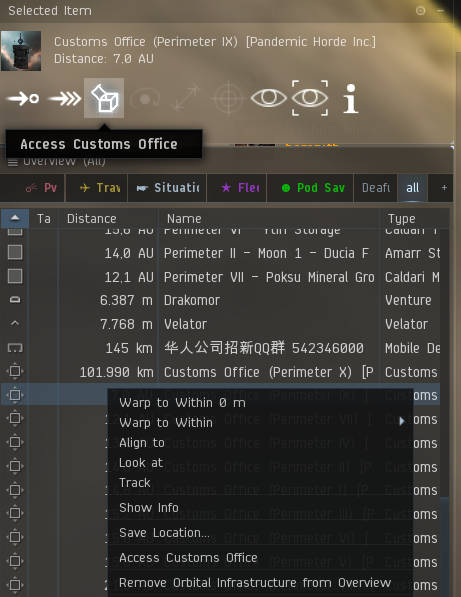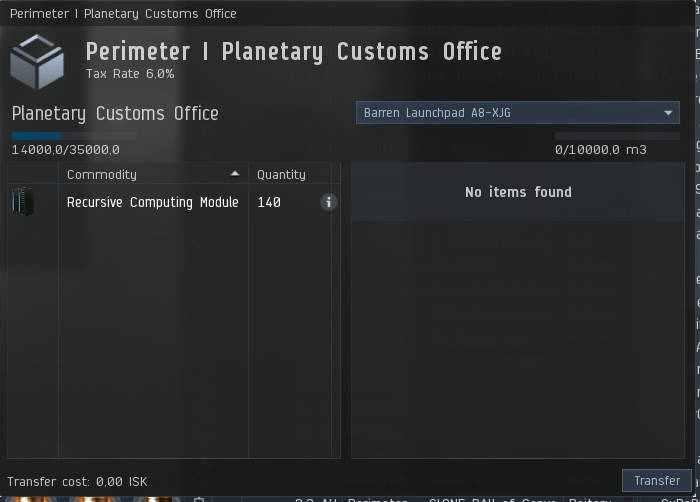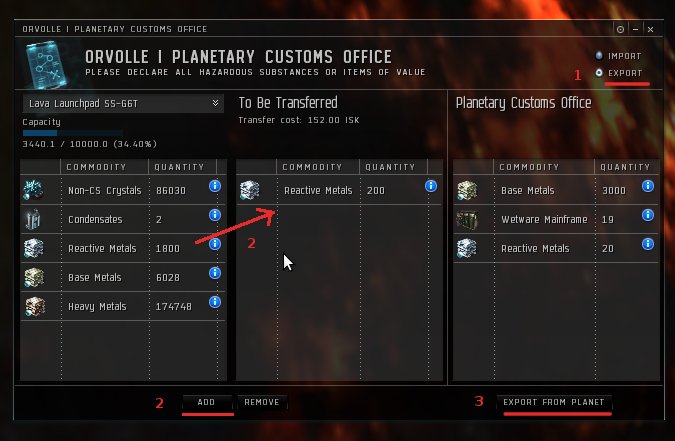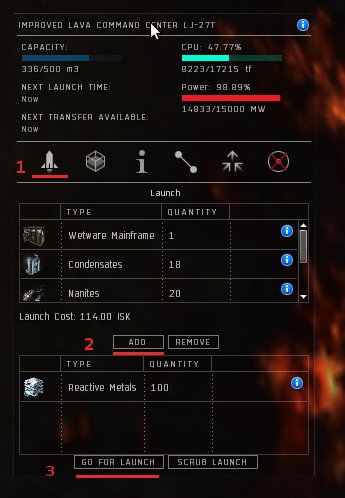Planetary Interaction
Contents
Overview
- What can you do with PI
- What Can't you do with PI
- You cannot attack another player's on-planet assets.
- What do you get out of investing time in PI
Skills
None of the skills related to PI are required to try it out. However, you'll be limited to a single command center (and thus single planet) of the lowest quality until you do some initial training. Thus you're most likely to get the best use out of training Interplanetary Consolidation and Command Center Upgrades first.
Click each skill link for more details
- Interplanetary Consolidation - Increases the number of planets you can install command
- Command Center Upgrades - Allows you to use better quality command centers
- Remote Sensing - Increases the range across which you can scan planets
- Planetology - ? Effect ?
- Advanced Planetology - ? Effect ?
Planets
For more details, see Planets
Planets come in all sorts of shapes and sizes, and accordingly provides differing materials. Each planet provides five resources, but a few unique resources only exist on a single planet. The unique resources include fill in the blanks here
At first you are limited to a single planet, so ideally you need to first figure out what you're interested in harvesting and/or producing, pick the planet most appropriate for that activity, and then look for an example with the right resources in abundance. general pointers for how abundant planets get in hisec goes here
To actually look for a planet you can use several different ways. You can fly to them and actually click the planet, or be lazy and just select the planets from your overview. Either way you'll want to "View in planet mode" and get yourself a nice up-close view
(insert screenie here)
You can also select planets from several other different views, like via the Atlas. The Remote Sensing skill will determine from how far away you can scan the deposit layouts of a planet. From outside you Remote Sensing range, you can:
- Enter Planet Mode, allowing you to view the relative abundances of resources on that planet (and gaze at its visual appeal)
- Manage a planet you have colonized
(This is still theorized - range seems to be somewhat or completely irrelevant at the moment as you can even manage planets in w-space from k-space)
Resources
For more details, see Planetary Resources
Put simple lists of resources of differing levels here, then the details and numbers on the detail page
- Raw Materials/uses
- T1 Goods/uses
- T2 Goods/uses
- T3 Goods/uses
Needs tables and correlation to the Planets info.
Scanning and Surveying
These two are distinct - "Scanning" in the PI context refers to scanning a planet for a specific raw material, bringing up a heat map showing geographic abundancy. Surveying is done from a placed Extractor and will show you what deposits are available to extract at that spot.
Planet Scanning
After you've familiarized yourself a bit with planets and resources, you'll probably want to extract one from the other. Finding a planet that is simply abundant in a resource you want is only the first step. Now you need to find out where on the planet you'll want to place your stuff. To get started, get yourself into Planet Mode and make sure you're on the "Scan" tab. You should see the five available resources, a "NO FILTER" bar, and a colorful "heat" bar.
Click any one resource and you'll get a heat map showing where on the planet that resource is abundant. The colored bar will allow you to modify the contrast of the heat map - as very rich or very poor resources may completely white out or appear invisible if your contrast is off. There are two triangles on the contrast bar. The left one will set the minimum resource abundance you want on the map (if you move it right poorer areas will disappear), and the right one will determine how rich a resource have to be to show as white (if you move it left poorer resources will show more distinctly). Ideally you'll want a balance where you can clearly see where the richer parts of the planet are.
(insert screenie(s) here)
You can leave a resource highlighted as you shift to the "Build" tab so you can more easily place an extractor on a rich spot. To remove the heat overlay click the "NO FILTER" bar.
Deposit Surveying
TODO - should all survey info go here and none go under Extractors on the building page? Probably
Planetary Buildings
For more details, see Planetary Buildings
To extract and produce resources and products you need buildings! Buildings match the planet they are constructed on, but players only need to worry about selecting the right type of command center, the rest are built in-place on the planet and thus always of the right type. At a glance, the following structures exist:
- Command Centers - The first building you must construct, deployed from orbit. Ranges in quality from basic to elite, providing more CPU and Powergrid per level. Can store a small amount of material and offers a simple rocket launch mechanism by which you can ship said materials to orbit.
- Extractors - Just as the name implies this structure extracts a resource from the planet it is on. You have to pick the resource type for the extractor as you build it, and must provide a route for the raw material to travel once extracted, lest it be lost. Additionally, you must manually initiate the extraction of a particular "seam" of the resource and submit your action before extraction begins.
- Processors- These come in three different types, Basic, Advanced, and High Tech. Each takes a set of raw materials and/or processed goods to produce a product of a specific tier.
- Storage Facilities - About as simple as a planetary building goes, these hulks simply store materials or goods, potentially as part of a larger logistics system.
- Launchpad - A building dedicated to moving materials and goods to and from the planet. Similar in function to the rocket launch function of the Command Center, but superior as it is connected to a Cargo Link in orbit above the planet, from where the owner can import and export goods. Very costly, however.
- Planetary Links - These can essentially be thought of as railroads, connecting different structures. In addition to being built (which has a base cost plus a distance cost) actual routes have to be defined using the links to route specific products across your planetary network. They have a finite capacity in m3 per hour and can be upgraded.
Industry
For more details, see Planetary Industry
Industry should focus on describing how buildings are united in the quest to produce stuff. In other words, how to simply make one planet do stuff
Due to the complexity of the combination process a basic command center will be of very limited use. An improved command center is recommended as a minimum starting point.
- What aspects of the economy are effected by PI
- NPC Seeded Goods/Production materials
- POS fuel, ect
- What ways are there to make money?
- Strip mining/Extractors only
- Low Level Production
- High Level Production/Running multiple colonies that feed eachother/Buying goods off the market to feed production
Colony Management
See Colony Management for details - may still want to segregate very heavy-screenshot examples of colonies on its own page?
While Industry should explain the "how" to use individual planets to create stuff, this section should describe at a high level which common colony types new players may be interested in and how to use multiple planets, other players, or the market to organize your planetary assets
- Colony setups
- Efficiently placing your building to maximize CPU/powergrid use and profit
- Ratios of Extractors/Production Buildings/Links/Storage that a Command Center can handle at any one time
- Storage (Surface, orbital cargo links, classic station hangars, ect)
- Managing multiple colonies
- Up to 6 colonies
- Resource gathering colonies/production colonies
- Hauling between colonies
Interplanetary Logistics
You do not have to setup your entire production chain on the one planet. You can purchase missing products on the market or produce them on other planets. However, then you need to get them down to the surface. In addition, ultimately you will want to get the fruits of your slave ..er "colonists'" labour to market.
These operations must be done in the system, and this exposes you to risk. There are two ways to get goods off a planet (Cargo Link/Customs Office, and Launch Container) and one way to get goods down to the planet (Cargo Link/Customs Office). Many of these operations are done near the "(Planet Name)'s Cargo Link", which you will have to add to your overview. The Cargo Link is like any other container, in that you must be within 2500m to transfer things into and out of it. However it is like your personal hanger in that things placed in it can only be seen by you. However, unlike your personal hanger, it has a capacity of only 10,000 m3, which is the same capacity as your launchpad.
Everything to do with the Customs Office must be done in the system, and in space. While you can perform the Import/Export operations out in the dark at a safe spot (need to check on whether it can be done cloaked), you must go to a known location to actually pick up the goods from the cargo link. The Launch Container method, while more expensive, can be done from anywhere in the universe, including docked at a station. However, you will still have to go to the system to pick up your launch can, and others can pick it up too if you don't get there first.
The Customs Office window is accessed either by right clicking on the Cargo Link, and choosing Access Customs Office, or from the rocket icon on a Launch Pad.
Importing: To import items to the planet, you must have a Launchpad (found Under Space Port in your list of buildings.) Having built this, the operation is to place the items in the Cargo Link in orbit. Next, right click on the Cargo Link and Access Customs Office. You can then move (or shift-drag to break up stacks) from the Planetary Customs Office pane on the left, to the To Be Transferred Pane in the middle. When you have everything setup to your desire, click on "Import To Planet". The items will arrive in your Launch Pad, and can then be transported elsewhere through Expedited Transfer or Routing. There is a cost of (quantify whether this is based on weight, volume, count or value. To transfer 400 Reactive Metals it cost 2000 ISK). (Appears to be 5 isk Import Tax per item)
For Export, you have two options: Launch or Export. Export is performed in the same way as Import, by Accessing the Customs Office, and clicking on the Export radio button in the upper right corner. This swaps the positions of the Customs Office and Launchpad such that the Launchpad(s) is/are over on the left. Add items to the shipment, or drag them to the centre "To Be Transferred" pane. When everything is to your satisfaction, click on Export From Planet. There is a cost of ( weight/volume/value/count? 4000 ISK to transfer 400 Reactive Metals). (10 isk Export Tax per item)
Alternatively, you can launch your products into orbit. This is performed from the Command Center's storage, and so each launch is limited to 500 m3. Click on the rocket icon in the Command Center (insert picture), which brings up the launch drop-panel(?), where you can pick whole stacks to go into the rocket by selecting it and then clicking on the Add button. Once you are satisfied, you can click on launch. It will then launch a package into orbit for you to pickup within the next 5 days. You can find your package and warp to it in your Journal, under the Planetary Launches tab. There is a cost of ( weight/volume/count? 6000 ISK for 400 Reactive Metals). (15 isk Export Tax per item)
To create a warpable bookmark (eg if you want to ask someone else to pickup for you), you must warp to the can and bookmark the can. There is no ranged warp available, but you might land more than 2000m from the can, so you may be able to do it without being decloaked. (Testing still under way for scanning down the package to say something about that. -Shiu)
(insert video clip? or series of pictures)
In summary:
- To get things to the planet, put them in the Cargo Link, and then import to a launch pad on the planet. 5 isk/item tax.
- To get things off the planet,
- Put them in a launch pad on the planet, export them, and pick them up from the cargo link. Maximum 10k m3, no one else can pickup, 10 isk/item tax.
- or Put them in Command Centre, launch them, and pick up from Journal bookmark. Maximum 500 m3. 15 isk/item. Others can pick up. Lofting the can into orbit can be done docked in station anywhere in the universe.
Profit!
This section could provide an initial layer of hints on how to optimize your PI work - about as advanced as the main guide page is likely to be. Or perhaps that should still be left on detail pages...
- Cultivating your colony
- Keeping tabs on Extractors and relocating them or surveying for new resources when your current vein is depleted
- Launching your goods for sale on the market
- Restructuring a colony to meet current needs
- Not forgetting it's there
To Help rember where you havesters are located place a can inside a station and label it with the planet and resource your working on. It will be easily visible from your assests page you can use teh search function to list all cans to sort if from your other stuff if you have especially crowded hangers.
- General guide to goods prices (post launch)
FAQ
- Q: Can I colonize planets in wormholes?
- A: Yes you can.
- Q: Can I attack another player's colony?
- A: No you cannot.
- Q: Can you deploy, manage or collect resources while cloaked?
- A: No. You can open the the cargo link while cloaked, but can not transfer. You can open the Customs Office from anywhere in the system, and setup the whole transfer while cloaked, but can not complete the transaction while cloaked. When considering this note also the danger that if your opponent found your colony on a particular planet, then sees you enter the system, they know which cargo link to sit on. (Just a note on the tricky operation of staying between 2050m and 2450m of the cargo link. In two tries, I was successful once, and the second time something decloaked me as I was creaping up to it, and it was not another player. It might be the sticky-out things problem that cloakies have with stations. Your opponent can guarantee it by orbiting at 2000m.)
- Q: Can you deploy, manage or collect resources from a freighter?
- A:
Term list
The following terms are defined here in an attempt to make them widely used and not ambiguous with similar terms
- Planet Mode - the view you enter to interact with a planet
- Scan - the act of scanning a planet for a particular resource (brings up a heat map)
- Survey - the act of surveying for deposits available to an extractor
- Resources - the various raw materials you can extract from planets. Could be nicknamed Planet Goo.
- Tiers / numbered products (P0, P1, etc) - raw materials (resources) are 0, then each level beyond that is a new set of products taking one manufacturing process
- Add your own!
Unsorted
- Tips
Planets may be managed from anywhere in range (depending on skills). Even while in warp. Planets can be managed from insided a station using the science and industry tool and clicking on the Planets tab.
To open the planet over view from anywhere Press f11 and in the side pannel you can use the bottem window to select planet view by right clicking the menue box in the left corner. By switching solarsytems or regions in the above boxes you can scan planets in regions as far as your abilities allow. In the solar system box you can use show info under each solar system and look at orbital bodies to get a list of planet type rather than look at them one at a time. You can also view planet directly from the list. You cannot deploy command centers while docked how ever you do not need to be at the planet however you must be in system.
http://www.eve-icsc.com/jumptools/jumpplanner.php use this link you calculate LY range to see what systems will be in range of your abilities it will help with planning.
- Struggles they may come up against, ect.
Related Links
- Eveonline forum thread on PI http://www.eveonline.com/ingameboard.asp?a=topic&threadID=1308696&page=4#102
- Planetary Interaction Taskforce - Central team organizing page
- Planets - Details on planets
- Planetary Industry - Details on PI production
- Colony - Details on colonies



